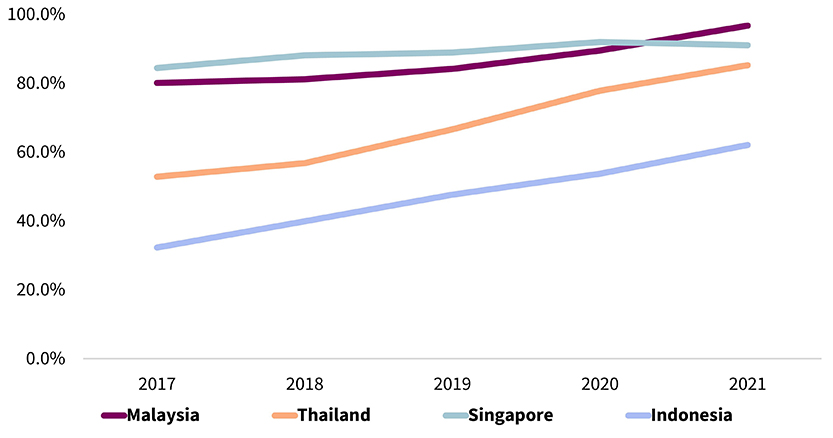Between 2017 and 2021, Malaysia saw the percentage of internet users rise from 80.1% to 96.8% – pitting the country against regional peers such as Singapore, Thailand, and Indonesia.
In 2021, we saw the launch of the MyDigital framework designed to accelerate the nation’s digital economy growth, replacing the previous MSC Malaysia. At present, the nation’s 5G rollout is fast on track to full deployment, exceeding the 40% 5G coverage target of 2022, according to Digital Nasional Berhad (DNB). The country had achieved close to 50% coverage of populated areas with some 3,900 sites nationwide.
Figure 1: Percentage of Population on Internet Usage

Source: International Telecommunication Union (ITU)
Hailed as a true game changer, the 5G rollout is well on its way to transforming our everyday lifestyle with the hype centred on lightning-fast network speed and ultra-low latency in mobile connectivity. Consequently, the higher usage of cloud-based services, the internet-of-things (IoT) and big data analytics will exponentially increase the amount of data being transmitted and stored, driving the demand for data centres – both from corporates and consumers.
Once a small niche market for a few selected, data centre is now gaining traction as a prospective investment asset in the real estate sector. With an estimated 4 million sqft of data centre supply currently in the pipeline at various planning and construction stages, Malaysia is firmly on its path to reaching the nation’s predicted growth of 500MW capacity by 2025 from its existing 212MW. While this may put us at a distance from Singapore’s estimated 1,000MW capacity as of 2021, every mile gained lessens the gap.
2022 saw more entrants and expansions of data centre projects in Malaysia. This includes Equinix Inc’s debut with the International Business Exchange (IBX) data centre (JH1) in Nusajaya Tech Park and NTT Ltd’s Cyberjaya 6 (CBJ6) data centre in Cyberjaya. In addition, there is an exclusive data centre development on a 150-acre freehold industrial parcel in the Delapan Special Border Economic Zone between AREA Advisory and Northern Gateway Sdn Bhd.
As an alternative sector with high power capacity requirements, the data centre segment will likely highlight the potential environmental issues emphasising the importance of green and sustainable features. This goes in line with the growing pool of ESG-compliant data centre operators who place importance on greenhouse gas emissions and energy efficiency. Locally, the government’s power generation plan is targeting 31% renewable energy in its installed capacity by 2025 and 40% by 2035, with the recent announcement of the Corporate Green Power Programme (CGPP) to encourage companies to use green energy such as solar.
Nevertheless, with the high usage of data comes the question of security. Currently, the Personal Data Protection Act 2010 (PDPA) is in place as the regulating law, albeit with some criticism on its long overdue revision. The Minister of Communications shares the government’s intent to review the Act while concurrently strengthening the public sector cyber security specialists, Cybersecurity Malaysia (CSM). One concern is that this could lead to a data onshore requirement by the government for security and privacy sakes as seen in some countries such as Vietnam and Indonesia. On the one hand, data onshore could give an added push to increasing local data centre presence. Conversely, this may limit data operators and service providers to stay local and not venture out elsewhere.
